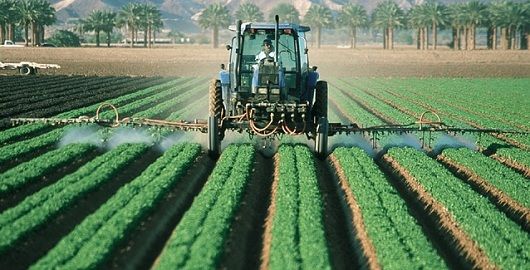Examining the Technological Developments Transforming Precision Farming Today
As the farming industry grapples with the obstacles of feeding an expanding populace and making sure sustainability, technological advancements are reshaping the landscape of precision farming. The complete effect of these technologies on typical farming practices and their lasting sustainability continues to be a subject ripe for expedition.
Drones in Farming

Drones assist in precise surveillance of big agricultural stretches, determining locations requiring focus, such as parasite problems or nutrient shortages. This targeted method enables the optimized application of plant foods, pesticides, and water, lowering waste and environmental effect. Moreover, drones substantially decrease the time and labor typically required for area inspections, raising efficiency and lowering functional costs.
Beyond data collection, drones contribute in precision growing and plant splashing, making sure consistent circulation and minimizing ground disruption. The integration of drones right into agriculture exemplifies a change towards data-driven farming methods, where modern technology not only augments traditional approaches however additionally presents cutting-edge options for future challenges. As the farming market encounters stress from environment adjustment and populace growth, drones present an appealing method for sustainable concentration and resource preservation.
Satellite Imagery Advancements
While drones have actually substantially improved precision farming through airborne data collection, satellite imagery continues to play a crucial function in widening the extent and scale of farming surveillance. Satellite technology uses huge protection, making it possible for farmers to accessibility critical understandings over comprehensive areas, which is not viable with drone innovation alone. This is specifically helpful for large-scale ranches that require extensive, constant information.
Developments in satellite imagery have actually caused considerable renovations in resolution and frequency of data capture. Modern satellites can now give images with resolutions as fine as 30 centimeters per pixel, allowing for detailed analysis of plant health and wellness, soil conditions, and watering patterns. Furthermore, the frequency of satellite passes has boosted, making sure that farmers can obtain current info regularly. This timely information is important for making educated, real-time choices to enhance plant yields and resource usage.
Moreover, the combination of multispectral and hyperspectral imagery has enhanced the data quality, enabling the accurate recognition of plant varieties, development stages, and stress factors. With artificial intelligence formulas, farmers can interpret satellite data better, forecasting plant performance and prospective concerns with extraordinary precision. These innovations are pivotal in improving sustainable agricultural techniques around the world.
IoT in Farming
The development of the Web of Things (IoT) in farming represents a standard shift in agricultural administration methods, supplying unequaled connectivity and data-driven understandings. As IoT devices multiply throughout farmland, they give real-time monitoring and control over various farming processes. These clever gadgets, which consist of soil sensors, climate stations, and animals monitoring systems, collect and transmit data to main platforms, making it possible for farmers to make enlightened choices and enhance resource use.
IoT technology helps with accuracy farming by enhancing the accuracy of data collected from the area. Dirt wetness sensing units can detect variations in dampness degrees, enabling for specific watering organizing, which saves water and advertises healthier plant development. Climate sensors offer critical info on temperature level and moisture, helping in insect and illness administration via timely interventions.
Additionally, IoT-enabled equipment, such as self-governing tractors and drones, further streamline procedures by automating labor-intensive tasks and minimizing human error. These technologies not just boost performance but additionally add to sustainability by decreasing inputs like water, fertilizers, and pesticides. As IoT remains to advance, its combination right into farming techniques read more will likely strengthen, driving productivity and sustainability in the agricultural industry.
AI-Driven Analytics
Structure upon the durable information collection abilities of IoT, expert system (AI) becomes a powerful device in transforming raw data into actionable insights for accuracy farming. AI-driven analytics leverages equipment learning formulas to assess vast datasets gathered from satellites, drones, and sensors. This enables farmers to make educated decisions pertaining to plant management, dirt health and wellness, and source allowance. By identifying patterns and predicting results, AI encourages farmers to enhance their practices, leading to raised yield and decreased waste.

Additionally, AI-driven analytics sustain precision farming by supplying tailored referrals for planting schedules and irrigation administration. These understandings help enhance water use, straightening with sustainability objectives. By delivering real-time insights and critical guidance, AI-driven analytics not just boost functional efficiency however also contribute towards lasting agricultural methods, securing food supply chains for the future.
Robotics and Automation
In the world of accuracy farming, robotics and automation are transforming agricultural methods by offering extraordinary performance and precision. These makers are outfitted with gps and sensors technology, allowing them to operate with high precision and adapt to differing field conditions.
Additionally, robotic systems enhance plant monitoring and management. Drones furnished with imaging innovation can survey big locations my explanation promptly, providing real-time information on crop health and dirt conditions.
The combination of robotics and automation in precision farming also deals with sustainability issues (commercial farming vs subsistence farming). By maximizing inputs and making best use of outcomes, these modern technologies aid decrease environmental impact. Subsequently, robotics and automation not only transform farming efficiency yet also add considerably to sustainable farming practices.
Conclusion
Technological developments are basically reshaping precision farming by integrating sophisticated devices like drones, satellite images, IoT Full Article gadgets, AI-driven analytics, and robotics. Robotics further enhance procedures, leading to set you back reductions and improved performance, inevitably changing conventional farming methodologies.
Changing the farming landscape, drones have emerged as a pivotal device in accuracy farming.IoT innovation promotes accuracy farming by boosting the precision of data gathered from the field.Structure upon the durable information collection abilities of IoT, fabricated intelligence (AI) emerges as an effective device in transforming raw information right into actionable insights for accuracy farming.In the realm of accuracy farming, robotics and automation are revolutionizing farming practices by supplying unmatched performance and accuracy.Technical innovations are essentially improving precision farming by incorporating sophisticated tools like drones, satellite imagery, IoT tools, AI-driven analytics, and robotics.